2. 中国科学院大学, 北京 100049;
3. 广西大学林学院, 南宁 530004
2. University of Chinese Academy of Sciences, Beijing 100049, China;
3. College of Forestry, Guangxi University, Nanning 530004, China
南方人工林是我国森林生态系统的重要组成部分,具有分布面积广、类型多的特点, 在固碳释氧、环境净化、水土保持等方面起着十分重要的作用,也是人们获得木材和其他生活、生产物质的重要自然资源[1-2]。人工林物种多样性的提高,可有效减轻林分病虫害的发生和增加生态系统的稳定性[3],然而,随着经济和城市的发展,对木材需求量的快速增长以及林业经营方式的不当造成人工林出现土壤肥力衰退、水土流失加剧和生态多样性下降等问题[4],因此,通过改造技术和管理措施来提高人工林生态系统的服务功能和潜力是当前社会最为关心的话题。
林分结构改善是生态恢复、提高人工林林地质量和土地生产力的有效途径之一[5]。尤其是林下植物在水土保持、养分循环、物种多样性保护、森林群落生产力的维持、群落构建和森林群落的恢复与演替等方面起着关键的作用[6-7]。近几十年来,人们逐步认识到林下植被在森林养分循环和稳定林分生产力等方面的重要作用[8],已有研究表明,不同的上层树种会形成特有的林下环境,从而影响林下层的物种组成[9]。在对欧洲森林生态系统的研究表明,上层植物多样性对下层植物多样性和系统发育结构的影响不显著[10-11],与下层植物生物量的相关性也很小,甚至为负相关[12]。但也有研究认为密度过大的林分对单位面积林下植被的生物量、平均高和总盖度等有影响,主要是因为上层植物影响林下光照,且林分密度可通过改变林分内的温湿度等环境条件来限制林下植物的生长[13-14]。Nilsson等[15]研究表明,瑞典的北方森林林下植物在长期尺度上会影响地下生态过程,如分解、能量流动和土壤养分。尽管在上层植物对下层植物的影响做了多方面的研究,然而,关于长期植被恢复的不同类型成熟人工林,研究其林下植物组成与多样性特征以及影响因素仍十分必要。
本研究以南亚热带经过30 a恢复的4种类型人工林:桉树混交林、马占相思纯林、乡土混交林和针叶混交林为研究对象,对林下植物群落多样性进行调查研究,以期揭示不同林分类型下,林下植物组成与多样性之间的差异性及其可能影响因素, 为亚热带人工林生物多样性保护、林分结构调整与森林恢复方面提供参考依据。
1 材料和方法 1.1 研究区概况研究区位于中国科学院鹤山森林生态系统国家野外科学观测研究站(简称鹤山站),地理位置为22°41′ N、112°54′ E,是典型的南亚热带季风气候, 有明显的干湿季节交替[16]。年平均气温为21.7 ℃, 最热月均温为29.2 ℃,最冷月均温为12.6 ℃,年均降水量为1 700 mm[17]。土壤为花岗岩风化形成的红壤[18]。早期受人为干扰严重,许多地区退化为荒坡地。自1984年起,鹤山站先后营造了多种人工林, 利用马占相思(Acacia mangium)、马尾松(Pinus massoniana)、尾叶桉(Eucalyptus urophylla)等有固氮作用或耐贫瘠生长快的树种作为先锋树种,经过30多年的恢复已经形成稳定成熟的林地。本研究我们选取了4种南亚热带具有代表性的常绿阔叶林分(表 1):桉树混交林(简称桉林)、马占相思纯林(简称马占相思林)、乡土混交林(简称乡土林)、针叶混交林(简称针叶林)。其中,桉林以速生、外来物种细叶桉(E. tereticornis)、赤桉(E. camaldulensis)为主;马占相思为豆科(Leguminosae)外来物种;乡土林为当地的高级演替阶段物种,主要树种包括木荷(Schima superba)、红锥(Castanopsis hystrix)、火力楠(Michelia macclurei)和阴香(Cinnamomum burmannii);针叶林以马尾松(P. massoniana)、湿地松(P. elliottii)和杉木(Cunninghamia lanceolata)为主。
| 表 1 固定样地基本信息 Table 1 Basic information of four plantations |
采用样方法,由于研究地4种人工林面积不同, 于2015年11月在桉林、针叶林、乡土林各设置9个5 m×5 m,马占相思林设16个5 m×5 m的随机样方,调查乔木幼苗和灌木,记录种名、胸径、树高和丛幅。在样方内设置2 m×2 m的小样方调查草本植物,记录种名、高度和盖度。并估测马占相思林、乡土林以及针叶林郁闭度。
1.3 土壤理化性质测定在每个人工林小样方中,用土钻采取土壤3钻表层土(0~20 cm),混合为1个土样,风干后过2 mm筛,用元素分析仪(Vario Elemental Analyzer, Lan- genselbold)测定土壤总有机碳(TOC)和全氮(TN)含量,钼锑抗比色法测定全磷(TP)含量[19],盐酸浸提法测定有效磷(AP)含量,硝态氮(NO3-N)用双波长法,铵态氮(NH4-N)用靛酚蓝比色法,土壤经过酸消煮后,采用火焰原子吸收法测定全钾(TK)含量[20]。
1.4 数据处理和分析物种丰富度指数表示种群在群落中的个体数目或丰富程度;α多样性指数采用Shannon-Wiener多样性指数[21]和Simpson优势度指数[22];均匀度指数采用Pielou指数[23];β多样性采用Jaccard相似性。
分别计算4种人工林林下灌木层和草本层的Shannon-Wiener多样性指数、Pielou均匀度指数和Simpson优势度指数。采用单因素方差分析(One- Way ANOVA)检测林型对林下植物多样性的影响, 并做箱线图,对4种林下植物多样性指数间的差异性进行Duncan多重比较,一元线性回归分析郁闭度对林下植物多样性的影响,统计分析采用SPSS 21.0软件,植物分布与土壤相关性采用冗余分析, 作图用Excel 2013和R.3.5.1软件。
2 结果和分析 2.1 物种丰富度4种类型人工林样地灌木层和草本层中共有35科52属60种植物(图 1),其中桉林林下有22科29属32种,灌木层有18科23属27种,以樟科(Lauraceae)植物最多(6种),占总种数的22.22%, 白花灯笼(Clerodendrum fortunatum)株数最多(132), 占总株数的43.3%;草本层有4科5属5种,禾本科(Poaceae)有2种,占总种数的40%,芒萁(Dicrano- pteris pedata)株数最多(891),占总株数的95.6%。马占相思林林下共有16科24属25种植物,灌木层有12科18属20种,其中樟科5种,占总种数的25%,茜草科(Rubiaceae)、桑科(Moraceae)、桃金娘科(Myrtaceae)各2种,分别占总种数的10%;草本层3科5属5种,种数最多的是禾本科(3种),占总种数的60%。相较于其余人工林,马占相思林灌木层的株数最少(280) (图 2),主要物种为秤星树(Ilex asprella) (111),占总株数的39.64%,而草本层的株数最多(1 315),植物优势度指数最高, 99.30%为芒萁。乡土林林下共有23科33属36种植物,灌木层有18科22属27种,樟科和叶下珠科(Phyllan- thaceae)种数较多,分别为5和3种,占总种数的18.52%和11.11%;灌木个体数较多(741), 其中九节(Psychotria asiatica)有350株, 占总株数的47.23%; 草本层有6科9属9种,禾本科、凤尾蕨科(Pteridaceae)和鳞始蕨科(Lindsaeaceae)各有2种,均占总种数的22.22%。针叶林林下共有24科37属41种植物, 灌木层16科22属25种,其中樟科4种, 占总种数的16%,茜草科、叶下珠科、大戟科(Euphorbiaceae)、冬青科(Aquifoliaceae)各有2种,均占总种数的8%;灌木层有729株植物,其中白花灯笼有373株,占总株数的51.17%;草本层内共有9科15属16种植物,其中禾本科有5种,鳞始蕨科3种,分别占总种数的31.25%和18.75%。
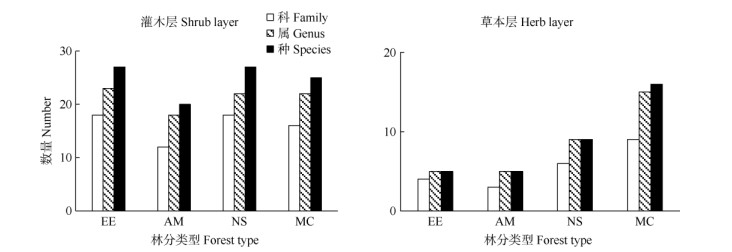
|
图 1 4种人工林林下植物种类。EE: 桉林; AM: 马占相思林; NS: 乡土林; MC: 针叶林。 Fig. 1 Species number of understory vegetation in four plantations. EE: Eucalyptus mixed plantation; AM: Acacia mangium plantation; NS: Mixed native species plantation; MC: Mixed coniferous plantation. |
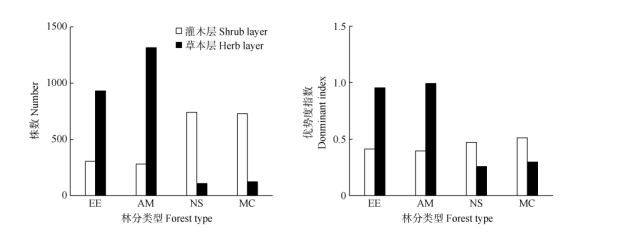
|
图 2 4种人工林林下植物株数和优势度指数。EE: 桉林; AM: 马占相思林; NS: 乡土林; MC: 针叶林。 Fig. 2 The individual number and dominance index of understory vegetation in four plantations. EE: Eucalyptus mixed plantation; AM: Acacia mangium plantation; NS: Mixed native species plantation; MC: Mixed coniferous plantation. |
从图 3可以看出,在灌木层中,马占相思林的Shannon-Wiener指数在4种林型中最小,乡土林最高,说明马占相思林灌木层的物种数较少,乡土林的较多;4种林型的均匀度无显著差异;桉林和马占相思林的Simpson指数较低,优势种明显, 而乡土林的最高,优势物种不明显。草本层中, 桉林和马占相思林的Shannon-Wiener指数、均匀度指数、Simpson指数均显著低于乡土林和针叶林(P < 0.05),而优势度指数则比较高,说明不同林型的林下植物多样性和植物组成具有一定的差异性。
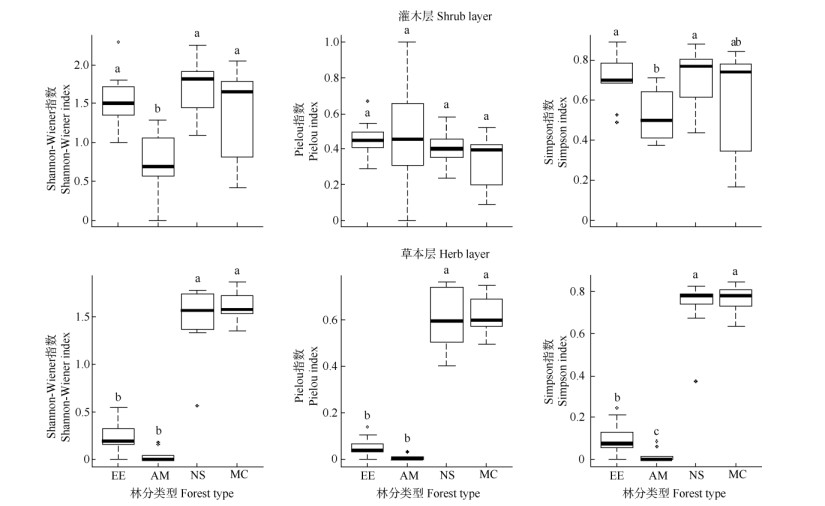
|
图 3 不同林型林下群落的物种多样性指数。EE: 桉林; AM: 马占相思林; NS: 乡土林; MC: 针叶林。柱上不同字母表示不同林型间差异显著(P < 0.05)。 Fig. 3 Diversity indexes of understory plantation species of different forest types. EE: Eucalyptus mixed plantation; AM: Acacia mangium plantation; NS: Mixed native species plantation; MC: Mixed coniferous plantation. Different letters upon column indicated significant difference among different forest types at 0.05 level. |
根据Jaccard相似性原理,相似系数为0.00~0.25时表示群落间极不相似,0.25~0.50为中等不相似,0.50~0.75为中等相似,0.75~1.00为极相似。
从表 2可见,4种不同林型林下灌木层和草本层植物群落的相似系数都低于0.75。在灌木层中, 马占相思林与乡土林的Jaccard相似系数为0.516, 桉林与马占相思林、针叶林分别为0.500和0.529, 均为中等相似;桉林与乡土林为0.459,针叶林与马占相思林、乡土林分别为0.452和0.444, 均为中等不相似。在草本层中,桉林与马占相思林,乡土林与针叶林间的Jaccard相似系数分别为0.667和0.563,为中等相似;乡土林与桉林、马占相思林间均为0.400,马占相思林与针叶林为0.313, 为中等不相似;桉林与针叶林间为0.235,为极不相似。
| 表 2 4种人工林林下植物群落的相似性 Table 2 Similarity of understory vegetation in four plantations |
图 4为不同林型郁闭度与林下灌木层、草本层物种多样性(Shannon-Wiener指数)的回归分析图。马占相思林的平均郁闭度为58.6%,乡土林为97.0%,针叶林为75.9%。森林郁闭度与林下植物多样性呈正相关关系(P < 0.001),马占相思林郁闭度与多样性整体低于乡土林、针叶林,乡土林郁闭度及物种多样性最高。

|
图 4 不同林型郁闭度与林下植物多样性的关系 Fig. 4 Relationship between canopy density and understory diversity in different plantation types |
从图 5可见,第1轴解释了群落物种分布变化的43.75%,主要反映了灌木层植物受土壤全氮、总有机碳、硝态氮和pH的影响,第2轴解释了群落物种分布变化的30.75%,主要反映了土壤全磷、全钾、有效磷、铵态氮的影响,前两轴合计解释了群落物种分布变化的74.50%。南亚热带人工林林下灌木层的物种分布主要受土壤总有机碳、全磷、全氮影响,其次是有效磷、硝态氮和铵态氮、pH的影响。同时,乡土林与磷的相关性高于其他类型人工林,pH、全钾与针叶林的关系比较密切,桉林和马占相思林主要与氮素形态相关。
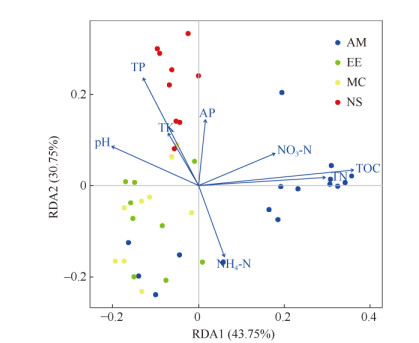
|
图 5 不同类型林分灌木层群落物种分布与土壤因子的冗余分析。TOC: 总有机碳; TN: 全氮; TP: 全磷; TK: 全钾; AP: 有效磷; NO3-N: 硝态氮; NH4-N: 铵态氮。 Fig. 5 Redundancy analysis (RDA) between species distribution in shrub layer of different forest types and soil physicochemical properties. TOC: Total soil carbon; TN: Total nitrogen; TP: Total phosphorus; TK: Total potassium; AP: Available phosphorus; NO3-N: Nitrate nitrogen; NH4-N: Ammonium nitrogen. The same is following Figures. |
通过对草本层林下植物物种数据进行RDA排序(图 6),第1轴解释了群落物种分布变化的83.12%, 主要反映了物种分布在全磷、全钾、有效磷影响下的变化。第2轴解释了群落物种分布变化的8.67%, 主要反映了物种分布在硝态氮、铵态氮影响下的变化。前两轴合计解释了群落物种分布变化的91.79%。南亚热带人工林林下草本层的物种分布主要受全磷、全钾、有效磷、pH和铵态氮影响, 其中,有效磷与乡土林林下草本植物分布的相关性比较高,针叶林林下草本主要与全磷、全钾和pH相关,桉林、马占相思林林下草本植物分布主要与土壤铵态氮、总有机碳和全氮相关,马占相思林与硝态氮的关系更密切。
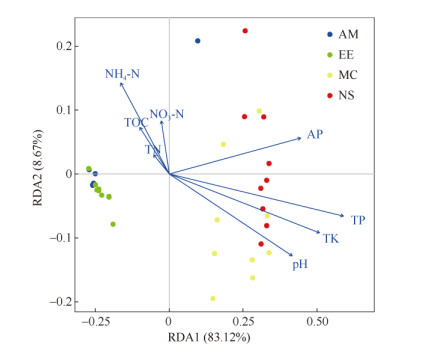
|
图 6 不同类型林分草本层群落物种分布与土壤理化因子的冗余分析。TOC: 总有机碳; TN: 全氮; TP: 全磷; TK: 全钾; AP: 有效磷; NO3-N: 硝态氮; NH4-N: 铵态氮。 Fig. 6 Redundancy analysis (RDA) between species distribution in shrub layer of different forest types and soil physicochemical properties. TOC: Total soil carbon; TN: Total nitrogen; TP: Total phosphorus; TK: Total potassium; AP: Available phosphorus; NO3-N: Nitrate nitrogen; NH4-N: Ammonium nitrogen. |
林下植物是森林生态系统的重要组成部分,研究林下植物的多样性维持机制有利于了解森林生态系统功能及其稳定性[8]。通过对鹤山站4种典型人工林林下植物群落进行调查,共记录植物35科52属60种,针叶林物种丰富度最高,共24科37属41种。一般认为,落叶阔叶林比常绿针叶林有更好的生物保育功能[24-25],另有研究认为,针叶林为本土树种,则可能不会对生物保育有负效应[26]。本研究4种林型皆能形成乔-灌-草的垂直群落结构,有较高的物种多样性。
群落相似性表征不同群落结构特征的相似程度[27],在4种人工林的林下灌木层和草本层中,群落相似性存在中等相似、中等不相似和极不相似的结果,说明林分类型影响林下物种及其多样性。植物群落多样性与森林的建群种有密切关系[28]。在营造人工林时,树种的选择对于其可持续经营有着重要影响作用[29]。通过对4种人工林林下群落多样性指数分析发现,在灌木层中,马占相思林Shannon- Wiener指数最低,原因可能是马占相思林为纯林, 单一的结构类型限制了其物种多样性的发展。而由于不同物种在根系模式、菌根联系、生长速率、以及养分需求等不同,混交林比纯林有更高效的养分利用率[30]。薛立等[31]对混交林土壤养分、微生物与酶活性的生态特性进行研究,表明营造混交林可以提高土壤肥力,防止地力衰退。因此,在南亚热带进行人工林植被恢复中,成熟混交林林下植物多样性优于纯林。在草本层中,桉林、马占相思林的群落多样性指数均显著低于乡土林、针叶林(P < 0.05),可能是因为芒萁在桉林、马占相思林为外来物种, 在样地中占据绝对优势地位,争夺大量的资源和空间,抑制了其他物种的生长。Bremer等[32]认为,与外来树种人工林相比,乡土树种人工林植物组成与当地自然林更相似,因此能促进更高的生物多样性。本研究的4种林型中,乡土林林下植物的多样性最高,优势度低,林下优势物种为耐阴九节以及种类丰富的蕨类和禾本科植物。因此,乡土树种具有较高的适应性、抗逆性以及稳定性等优势,乡土林能够增强抵御干扰的能力,逐渐改善林地生态系统,有利于森林生态系统的健康和稳定性[33]。维持植物多样性,应采取合理的管理措施,防止林下耐阴植物物种丧失[34]。
3.2 郁闭度对林下层植物的影响光照强度影响林下群落组成,森林中林下光环境变异较大,可以为不同光照需求的物种提供多样的小生境[35],从而影响林下植物的多样性以及群落结构[34]。研究结果表明,桉林、马占相思林林下灌木个体少,阳性草本植物芒萁占比大,而乡土林和针叶林林下灌木个体多,草本层蕨类占比大。林分通常因为冠形、冠层结构的差异或树种的组分不同以及林分密度的大小而对林下植被的生长、分布有着较大的影响[36-38]。通过分析马占相思林、乡土林以及针叶林郁闭度与林下植物多样性关系,林分郁闭度与林下植物多样性呈正相关关系,马占相思林郁闭度与多样性整体低于乡土林、针叶林,而乡土林郁闭度及物种多样性最高,可能是经过30 a林分恢复,马占相思林已进入后熟期,生态服务功能退化[39]。李莲珠等[40]报道马占相思林主要根系(83.90%)分布在0~40 cm深的土层中,浅层根系更易遭受频繁的台风干扰,而台风干扰是林下光照强的重要原因[41-42]。郁闭度低,光照条件强,环境过滤减少了光照要求低的植物[43-44],与此相反,乡土混交林、针叶混交林林分密度与郁闭度更高,林下较弱的光照更适合耐阴植物生长,比如蕨类,通常定植于阴凉潮湿的微环境中[45]。
3.3 土壤因子与林下植物组成的关系物种的分布范围与复杂的环境相关[46],在大尺度上,气候因子的影响较大,在中等尺度上,干扰起主要作用,地形和土壤因子主要作用于小尺度上的范围[47]。分析表明,土壤磷、pH和全钾与林下灌草分布相关性大,马占相思林土壤氮含量高,可能与马占相思固氮作用有关。另一方面,物种多样性越高,土壤中的主要限制因子矿化氮更能被充分利用,从而降低了土壤库中氮的含量[48],这可能是乡土林、针叶林物种多样性高而土壤氮含量低的潜在原因。土壤酸性磷酸酶(ACP)活性的高低直接影响着土壤有机磷分解转化及其生物有效性[49],乡土林林下植物及针叶林草本层分布与土壤磷相关,表征乡土林土壤中涉及磷循环的生物活动作用强度高,这与郑威等[50]对桉树人工林与乡土林土壤性质的研究一致;谭宏伟等[49]的研究也表明南亚热带地区马尾松人工林土壤ACP活性较高。针叶林土壤酸碱度较高,可能是马尾松成熟林林下植被丰富, 物种多样,群落内的枯枝落叶及植物残体在总的凋落物组分中的比例提高,凋落物组分的改变在一定程度上导致成熟针叶林pH升高[51]。在对人工林的管理过程中,应注意土壤对植物的影响,以更好地保护人工林植物多样性。
| [1] |
REN X L, HE H L, LIU M, et al. Modeling of carbon and water fluxes of Qianyanzhou subtropical coniferous plantation using model-data fusion approach[J]. Acta Ecol Sin, 2012, 32(23): 7313-7326. 任小丽, 何洪林, 刘敏, 等. 基于模型数据融合的千烟洲亚热带人工林碳水通量模拟[J]. 生态学报, 2012, 32(23): 7313-7326. DOI:10.5846/stxb201203230397 |
| [2] |
GONG Y B. Understory species diversity and biomass of natural broad-leaved Korean pine forest[D]. Beijing: Beijing Forestry University, 2016: 1-63. 龚艳宾. 天然阔叶红松林下植被物种多样性及生物量研究[D]. 北京: 北京林业大学, 2016: 1-63. |
| [3] |
LIN K M, HUANG B L. Studies on β-diversity index of undergrowth plant in Chinese fir plantation[J]. Biodiv Sci, 2001, 9(2): 157-161. 林开敏, 黄宝龙. 杉木人工林林下植物物种β多样性的研究[J]. 生物多样性, 2001, 9(2): 157-161. DOI:10.17520/biods.2001024 |
| [4] |
FANG Y R, CAI J H, XUE L. Undergrowth plant diversity and soil physical properties in three reformed plantations[J]. J S China Agric Univ, 2018, 39(4): 87-92. 方怡然, 蔡金桓, 薛立. 3种改造人工林的林下植物多样性和土壤物理性质[J]. 华南农业大学学报, 2018, 39(4): 87-92. DOI:10.7671/j.issn.1001-411X.2018.04.014 |
| [5] |
PENG J H, WANG H, ZOU D S, et al. Soil quality assessment of forest stand in several typical plantation forest ecosystems in subtro-pical region[J]. Chin J Soil Sci, 2010, 41(1): 93-99. 彭佳红, 王华, 邹冬生, 等. 亚热带区域几种典型人工林生态系统林地土壤质量评价[J]. 土壤通报, 2010, 41(1): 93-99. DOI:10.19336/j.cnki.trtb.2010.01.020 |
| [6] |
ONAINDIA M, DOMINGUEZ I, ALBIZU I, et al. Vegetation diver-sity and vertical structure as indicators of forest disturbance[J]. For Ecol Manag, 2004, 195(3): 341-354. DOI:10.1016/j.foreco.2004.02.059 |
| [7] |
WANG Y Q, CAI Y R, ZENG H C, et al. Composition and diversity of understory plant species in subtropical forests under different canopy openness[J]. J NW Agric For Univ (Nat Sci), 2016, 44(5): 64-72, 81. 王永强, 蔡燕茹, 曾焕忱, 等. 不同林冠开度下亚热带林下植物的组成和多样性[J]. 西北农林科技大学学报(自然科学版), 2016, 44(5): 64-72, 81. DOI:10.13207/j.cnki.jnwafu.2016.05.009 |
| [8] |
HUANG R X, XU M F, LIU T, et al. Environmental interpretation and species diversity of understory vegetation in 5 subtropical forest types[J]. J SW For Univ, 2020, 40(2): 53-62. 黄润霞, 徐明锋, 刘婷, 等. 亚热带5种森林类型林下植物物种多样性及其环境解释[J]. 西南林业大学学报, 2020, 40(2): 53-62. DOI:10.11929/j.swfu.201901016 |
| [9] |
EVY A, FEDERICO S, HARALD A, et al. Driving mechanisms of overstorey-understorey diversity relationships in European forests[J]. Perspect Plant Ecol Evol Syst, 2016, 19: 21-29. DOI:10.1016/j.ppees.2016.02.001 |
| [10] |
DE GROOTE S R E, VAN SCHROJENSTEIN LANTMAN I M, SERCU B K, et al. Tree species identity outweighs the effects of tree species diversity and forest fragmentation on understorey diversity and composition[J]. Plant Ecol Evol, 2017, 150(3): 229-239. DOI:10.5091/plecevo.2017.1331 |
| [11] |
COPPI A, LAZZARO L, AMPOORTER E, et al. Understorey phylo-genetic diversity in thermophilous deciduous forests: Overstorey species identity can matter more than species richness[J]. For Ecosyst, 2019, 6(1): 37. DOI:10.1186/s40663-019-0191-1 |
| [12] |
ZHANG Y, CHEN H Y H, TAYLOR A R. Aboveground biomass of understorey vegetation has a negligible or negative association with overstorey tree species diversity in natural forests[J]. Glob Ecol Biogeogr, 2016, 25(2): 141-150. DOI:10.1111/geb.12392 |
| [13] |
HOLAH J C, WILSON M V, HANSEN E M. Effects of a native forest pathogen, Phellinus weirii, on Douglas-fir forest composition in western Oregon[J]. Can J For Res, 1993, 23(12): 2473-2480. DOI:10.1139/x93-307 |
| [14] |
LIN K M, YU X T, HE Z Y, et al. Study on the difference of biomass structure and soil fertility in Chinese fir stands of different densities[J]. Sci Silv Sin, 1996, 32(5): 385-392. 林开敏, 俞新妥, 何智英, 等. 不同密度杉木林分生物量结构与土壤肥力差异研究[J]. 林业科学, 1996, 32(5): 385-392. |
| [15] |
NILSSON M C, WARDLE D A. Understory vegetation as a forest ecosystem driver: Evidence from the northern Swedish boreal forest[J]. Front Ecol Environ, 2005, 3(8): 421-428. DOI:10.1890/1540-9295(2005)003[0421:UVAAFE]2.0.CO;2 |
| [16] |
XI D, LI J, KUANG Y W, et al. Variation of soil non-labile carbon under different forest types in Heshan[J]. J Trop Subtrop Bot, 2013, 21(3): 203-210. 习丹, 李炯, 旷远文, 等. 鹤山不同植被类型土壤惰性碳含量及其季节变化特征[J]. 热带亚热带植物学报, 2013, 21(3): 203-210. DOI:10.3969/j.issn.1005-3395.2013.03.002 |
| [17] |
LI Y L, PENG S L, ZHAO P, et al. A study on the soil carbon storage of some land use types in Heshan, Guangdong, China[J]. J Mt Sci, 2002, 20(5): 548-552. 李跃林, 彭少麟, 赵平, 等. 鹤山几种不同土地利用方式的土壤碳储量研究[J]. 山地学报, 2002, 20(5): 548-552. DOI:10.3969/j.issn.1008-2786.2002.05.007 |
| [18] |
YU Z Y, PENG S L. Ecological Studies on Vegetation Rehabilitation of Tropical and Subtropical Degraded Ecosystems[M]. Guangzhou: Guangdong Science and Technology Press, 1996: 1-266. 余作岳, 彭少麟. 热带亚热带退化生态系统植被恢复生态学研究[M]. 广州: 广东科技出版社, 1996: 1-266. |
| [19] |
DELGADO-BAQUERIZO M, FRY E L, ELDRIDGE D J, et al. Plant attributes explain the distribution of soil microbial communities in two contrasting regions of the globe[J]. New Phytol, 2018, 219(2): 574-587. DOI:10.1111/nph.15161 |
| [20] |
LI H, XU Z W, YAN Q Y, et al. Soil microbial beta-diversity is linked with compositional variation in aboveground plant biomass in a semi-arid grassland[J]. Plant Soil, 2018, 423(1-2): 465-480. DOI:10.1007/s11104-017-3524-2 |
| [21] |
SHANNON C E, WEAVER W. The Mathematical Theory of Commu-nication[M]. 16th ed. Urbana: University of Illinois Press, 1971: 1-144.
|
| [22] |
MAGURRAN A E. Ecological Diversity and its Measurement[M]. Princeton, New Jersey: Princeton University Press, 1988: 1-192.
|
| [23] |
WHITTAKER R H. Evolution and measurement of species diversity[J]. Taxon, 1972, 21(2、3): 213-251. DOI:10.2307/1218190 |
| [24] |
LEMENIH M, TEKETAY D. Effect of prior land use on the recolo-nization of native woody species under plantation forests in the high-lands of Ethiopia[J]. For Ecol Manag, 2005, 218(1/2/3): 60-73. DOI:10.1016/j.foreco.2005.07.010 |
| [25] |
AUBIN I, MESSIER C, BOUCHARD A. Can plantations develop understory biological and physical attributes of naturally regenerated forests[J]. Biol Conserv, 2008, 141(10): 2461-2476. DOI:10.1016/j.biocon.2008.07.007 |
| [26] |
PARITSIS J, AIZEN M A. Effects of exotic conifer plantations on the biodiversity of understory plants, epigeal beetles and birds in Nothofagusdombeyi forests[J]. For Ecol Manag, 2008, 255(5/6): 1575-1583. DOI:10.1016/j.foreco.2007.11.015 |
| [27] |
JIANG H Q, DUAN C Q, YANG S H, et al. Plant Ecology[M]. 2nd ed. Beijing: Higher Education Press, 2010: 1-316. 姜汉侨, 段昌群, 杨树华, 等. 植物生态学[M]. 第2版. 北京: 高等教育出版社, 2010: 1-316. |
| [28] |
WANG Z B, DU Y C, SUN J J, et al. Study on the biodiversity of planted Larix principis-rupprechtii forest in Yanshan mountainous regions[J]. Hebei J For Orchard Res, 2009, 24(3): 237-243. 王志彬, 杜彦超, 孙建军, 等. 燕山山地华北落叶松人工林生物多样性研究[J]. 河北林果研究, 2009, 24(3): 237-243. DOI:10.3969/j.issn.1007-4961.2009.03.003 |
| [29] |
DONG H H, QIU L, ZHANG J S, et al. Study on the diversity of undergrowth plant in four typical plantations in Huangbaishan Mountain[J]. For Res Manag, 2019(4): 86-91. 董卉卉, 邱林, 张建设, 等. 黄柏山4种典型人工林林下植物多样性研究[J]. 林业资源管理, 2019(4): 86-91. DOI:10.13466/j.cnki.lyzygl.2019.04.013 |
| [30] |
HARTLEY M J. Rationale and methods for conserving biodiversity in plantation forests[J]. For Ecol Manag, 2002, 155(1/2/3): 81-95. DOI:10.1016/S0378-1127(01)00549-7 |
| [31] |
XUE L, KUANG L G, CHEN H Y, et al. Soil Nutrients, Microorganisms and enzyme activities of different stands[J]. Acta Pedol Sin, 2003, 40(2): 280-285. 薛立, 邝立刚, 陈红跃, 等. 不同林分土壤养分、微生物与酶活性的研究[J]. 土壤学报, 2003, 40(2): 280-285. DOI:10.3321/j.issn:0564-3929.2003.02.018 |
| [32] |
BREMER L L, FARLEY K A. Does plantation forestry restore biodi-versity or create green deserts? A synthesis of the effects of land-use transitions on plant species richness[J]. Biodiv Conserv, 2010, 19(14): 3893-3915. DOI:10.1007/s10531-010-9936-4 |
| [33] |
ZHOU X P. Role of native tree species in ecological restoration process of Ninghua County[J]. Modern Agric Sci Technol, 2020(20): 122-124. 周晓平. 乡土树种在宁化县生态恢复过程中的作用[J]. 现代农业科技, 2020(20): 122-124. DOI:10.3969/j.issn.1007-5739.2020.20.047 |
| [34] |
LIU T Y, LIN K C, VADEBONCOEUR M A, et al. Understorey plant community and light availability in conifer plantations and natural hardwood forests in Taiwan[J]. Appl Veg Sci, 2015, 18(4): 591-602. DOI:10.1111/avsc.12178 |
| [35] |
HU Y Q, KE X D, XU M F, et al. Herbaceous plant in response to understory light regimes in a subtropical forest community[J]. J CS Univ For Technol, 2016, 36(8): 72-76. 胡砚秋, 柯娴氡, 徐明锋, 等. 亚热带森林群落草本植物对林下光环境的响应[J]. 中南林业科技大学学报, 2016, 36(8): 72-76. DOI:10.14067/j.cnki.1673-923x.2016.08.014 |
| [36] |
ALABACK P B. Dynamics of understory biomass in Sitka spruce-western hemlock forests of southeast Alaska[J]. Ecology, 1982, 63(6): 1932-1948. DOI:10.2307/1940131 |
| [37] |
STEWART G H. Forest development in canopy openings in old-growth Pseudotsuga forests of the western Cascade Range, Oregon[J]. Can J For Res, 1986, 16(3): 558-568. DOI:10.1139/x86-097 |
| [38] |
SHENG W T. A long-term study on development and succession of undergrowth vegetations in Chinese fir (Cunninghamia lanceolata) plantations with different density[J]. For Res, 2001, 14(5): 463-471. 盛炜彤. 不同密度杉木人工林林下植被发育与演替的定位研究[J]. 林业科学研究, 2001, 14(5): 463-471. DOI:10.3321/j.issn:1001-1498.2001.05.001 |
| [39] |
CHU S S, ZHANG B, MO L J, et al. Effects of forest stand treatments on water, soil and nutrient reservation by Acacia mangium plantations in South China[J]. J Soil Water Conserv, 2014, 28(3): 72-77. 储双双, 张兵, 莫罗坚, 等. 林分改造对马占相思林水土和养分保持效能的影响[J]. 水土保持学报, 2014, 28(3): 72-77. DOI:10.13870/j.cnki.stbcxb.2014.03.014 |
| [40] |
LI L Z, ZHENG W, TIAN L Y, et al. Root distribution characteristics of Acacia mangium plantation and its relationship with soil nutrients in Fengmu Experimental Forest Farm, Hainan province[J]. Trop For, 2020, 48(3): 48-52. 李莲珠, 郑伟, 田乐宇, 等. 海南省枫木实验林场马占相思人工林根系分布特征及其与土壤养分的关系[J]. 热带林业, 2020, 48(3): 48-52. DOI:10.3969/j.issn.1672-0938.2020.03.010 |
| [41] |
LIN T C, HAMBURG S P, HSIA Y J, et al. Influence of typhoon disturbances on the understory light regime and stand dynamics of a subtropical rain forest in northeastern Taiwan[J]. J For Res, 2003, 8(3): 139-145. DOI:10.1007/s10310-002-0019-6 |
| [42] |
LIN T C, HAMBURG S P, LIN K C, et al. Typhoon disturbance and forest dynamics: Lessons from a northwest Pacific subtropical forest[J]. Ecosystems, 2011, 14(1): 127-143. DOI:10.1007/s10021-010-9399-1 |
| [43] |
PACKHAM J R, WILLIS A J. The effects of shading on Oxalis acetosella[J]. J Ecol, 1977, 65(2): 619-642. DOI:10.2307/2259505 |
| [44] |
SCHNEIDER H, SCHUETTPELZ E, PRYER K M, et al. Ferns diversified in the shadow of angiosperms[J]. Nature, 2004, 428(6982): 553-557. DOI:10.1038/nature02361 |
| [45] |
WATKINS J E JR, CARDELÚS C L. Ferns in an angiosperm world: Cretaceous radiation into the epiphytic niche and diversification on the forest floor[J]. Int J Plant Sci, 2012, 173(6): 695-710. DOI:10.1086/665974 |
| [46] |
KANG Y, XIONG M H, HUANG J, et al. Variation in woody plant functional traits of the tropical cloud forests in Bawangling, Hainan Island[J]. Acta Ecol Sin, 2017, 37(5): 1572-1582. 康勇, 熊梦辉, 黄瑾, 等. 海南岛霸王岭热带云雾林木本植物功能性状的分异规律[J]. 生态学报, 2017, 37(5): 1572-1582. DOI:10.5846/stxb201510082023 |
| [47] |
LIU X J, MA K P. Plant functional traits: Concepts, applications and future directions[J]. Sci Sin Vitae, 2015, 45(4): 325-339. 刘晓娟, 马克平. 植物功能性状研究进展[J]. 中国科学: 生命科学, 2015, 45(4): 325-339. DOI:10.1360/N052014-00244 |
| [48] |
TILMAN D, WEDIN D, KNOPS J. Productivity and sustainability influenced by biodiversity in grassland ecosystems[J]. Nature, 1996, 379(6567): 718-720. DOI:10.1038/379718a0 |
| [49] |
TAN H W, YANG S D, WU J, et al. Comparison of Eucalyptus plantation with and other forests in soil microbial activity and bacterial diversity in red soil region, China[J]. Acta Pedol Sin, 2014, 51(3): 575-584. 谭宏伟, 杨尚东, 吴俊, 等. 红壤区桉树人工林与不同林分土壤微生物活性及细菌多样性的比较[J]. 土壤学报, 2014, 51(3): 575-584. DOI:10.11766/trxb201309170421 |
| [50] |
ZHENG W, LI C X, TAN L, et al. Comparison of Eucalyptus plantation and typical native species plantations in soil phosphorus fractions and sorption characteristics in south subtropical China[J]. Soils, 2020, 52(5): 1017-1024. 郑威, 李晨曦, 谭玲, 等. 南亚热带桉树人工林与典型乡土树种人工林土壤磷组分及磷吸附特性比较[J]. 土壤, 2020, 52(5): 1017-1024. DOI:10.13758/j.cnki.tr.2020.05.020 |
| [51] |
CUI N J, ZHANG D J, LIU Y, et al. Plant diversity and soil physico-chemical properties under different aged Pinus massoniana plantations[J]. Chin J Ecol, 2014, 33(10): 2610-2617. 崔宁洁, 张丹桔, 刘洋, 等. 不同林龄马尾松人工林林下植物多样性与土壤理化性质[J]. 生态学杂志, 2014, 33(10): 2610-2617. DOI:10.13292/j.1000-4890.2014.0221 |
 2022, Vol. 30
2022, Vol. 30



